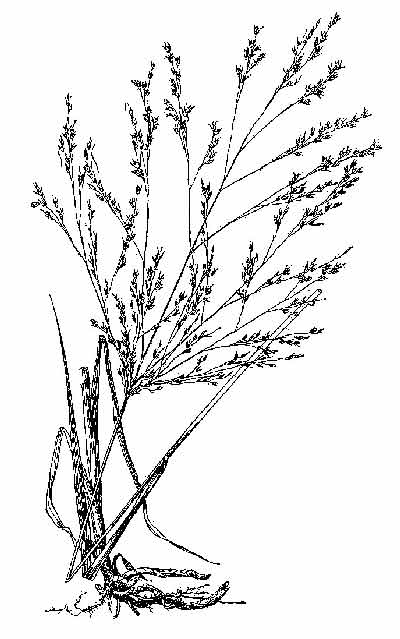
Switchgrass
by Sharon LaPlante
Switchgrass, Panicum
virgatum, is a perennial bunch grass that spreads by rhizomes to form
colonies. The average height is three to six feet. The stems are tough, hard and hollow. The ligule (the appendage that arises
from the surface of a leaf junction with the leaf sheath) is a dense ring of
hairs. The leaf blades are flat and
up to 30 inches in length and 1/2 an inch in width. The seed head is an open panicle up to 10 inches in length. The spikelets (a single flower within a
grass's inflorescence) are up to 3/16 of an inch in length, which is considered
large for the genus.
Switchgrass is one of the tallest panicums of the
southeast. It grows throughout the
southeast occurring in wet flatwoods, prairies, open woods, and brackish marshes
in Florida. In Arkansas it grows in
rocky soils, and in Tennessee it grows in grassy plains. Its tolerance of shade make it an
important native grass in forested areas. It
is adapted to floodplains, however it does occur on sandhills.
Major foliage growth occurs during March to September. Rhizome growth is most active in
January, February, March, and April. Seed heads
are formed in August to October.
It is an excellent source of grazing forage for livestock and deer. The large seeds that are produced in quantity provide an excellent food source for birds, especially quail.
Hitchcock, A.S.. Manual of the Grasses of the United States (vol. 1 vol. 2). Dover Publications: New York, NY. 1971
Tobe, Ph.D., John D. et al. Florida Wetland Plants: An Identification Manual. UF/IFAS Publications: Gainesville, FL. 1998
Yartlett, Lewis L. Common Grasses of Florida and the Southeast. The Florida Native Plant Society: Spring Hill, FL. 1996
Return to the Main Page
All material on this site © Hernando Chapter of the FNPS. The materials on this website may be copied and distributed without permission, provided that it is used for non-commercial, informational or educational purposes, and you acknowledge this site and the Hernando Chapter of the Florida Native Plant Society as the source of publication.